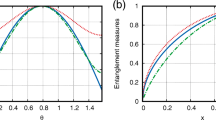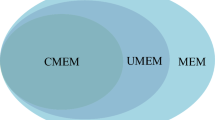Abstract
By regarding quantum states as communication channels and using observable correlations quantitatively expressed by mutual information, we introduce a hierarchy of entanglement measures that includes the entanglement of formation as a particular instance. We compare the maximal and minimal measures and indicate the conceptual advantages of the minimal measure over the entanglement of formation. We reveal a curious feature of the entanglement of formation by showing that it can exceed the quantum mutual information, which is usually regarded as a theoretical measure of total correlations. This places the entanglement of formation in a broader scenario, highlights its peculiarity in relation to pure-state ensembles, and introduces a competing definition with intrinsic informational significance.
Similar content being viewed by others
References
A. Einstein, B. Podolsky, and N. Rosen, Phys. Rev., 47, 777–780 (1935).
E. Schrödinger, Proc. Cambridge Philos. Soc., 31, 555–563 (1935); 32, 446–452 (1936); Naturwissenchaften, 23, 807–812, 823–828, 844–849 (1935).
J. S. Bell, Physics, 1, 195 (1964); J. F. Clauser and A. Shimony, Rep. Progr. Phys., 41, 1881–1927 (1978); A. Aspect, P. Grangier, and G. Roger, Phys. Rev. Lett., 47, 460–463 (1981).
M. A. Nielsen and I. L. Chuang, Quantum Computation and Quantum Information, Cambridge Univ. Press, Cambridge (2000).
C. H. Bennett, D. P. DiVincenzo, J. A. Smolin, and W. K. Wootters, Phys. Rev. A, 54, 3824–3851 (1996).
W. K. Wootters, Quantum Inf. Comput., 1, 27–44 (2001).
M. Horodecki, Quantum Inf. Comput., 1, 3–26 (2001).
C. M. Caves, C. A. Fuchs, and P. Rungta, Found. Phys. Lett., 14, 199–212 (2001).
M. Horodecki, P. Horodecki, and R. Horodecki, Phys. Rev. Lett., 80, 5239–5242 (1998).
V. Vedral, M. B. Plenio, M. A. Rippin, and P. L. Knight, Phys. Rev. Lett., 78, 2275–2279 (1997); V. Vedral and M. B. Plenio, Phys. Rev. A, 57, 1619–1633 (1998).
G. Vidal and R. F. Werner, Phys. Rev. A, 65, 032314 (2002).
M. Christandl and A. Winter, J. Math. Phys., 45, 829–840 (2004).
P. W. Shor, Comm. Math. Phys., 246, 453–472 (2004); K. M. R. Audenaert and S. L. Braunstein, Comm. Math. Phys., 246, 443–452 (2004).
H. Everett III, “The theory of the universal wavefunction,” in: The Many-Worlds Interpretation of Quantum Mechanics (B. S. DeWitt and N. Graham, eds.), Princeton Univ. Press, Princeton, N. J. (1973), p. 3.
C. E. Shannon, Bell Syst. Tech. J., 27, 379–423, 623–656 (1948).
T. M. Cover and J. A. Thomas, Elements of Information Theory, Wiley, New York (1991).
B. Schumacher, “Information from quantum measurements,” in: Complexity, Entropy, and the Physics of Information (Santa Fe Inst. Studies in Sciences of Complexity, Vol. 8, W. H. Zurek, ed.), Addison-Wesley, Redwood City, Calif. (1990), p. 29.
R. Jozsa, D. Robb, and W. K. Wootters, Phys. Rev. A, 49, 668–677 (1994).
A. S. Kholevo, Probl. Inf. Transm., 15, 247–253 (1979).
V. Vedral, Rev. Modern. Phys., 74, 197–234 (2002).
S. Popescu and D. Rorhlich, Phys. Rev. A, 56, R3319–R3321 (1997).
R. F. Werner, Phys. Rev. A, 40, 4277–4281 (1989).
K. G. H. Vollbrecht and R. F. Werner, Phys. Rev. A, 64, 062307 (2001).
C. Adami and N. J. Cerf, Phys. Rev. A, 56, 3470–3483 (1997); L. Henderson and V. Vedral, J. Phys. A, 34, 6899–6905 (2001); H. Ollivier and W. H. Zurek, Phys. Rev. Lett., 88, 017901 (2002); B. Groisman, S. Popescu, and A. Winter, Phys. Rev. A, 72, 032317 (2005); B. Schumacher and M. D. Westmoreland, Phys. Rev. A, 74, 042305 (2006).
G. Vidal, J. Modern Opt., 47, 355–376 (2000).
M. Horodecki, P. Horodecki, and R. Horodecki, Phys. Rev. Lett., 84, 2014–2017 (2000).
P. M. Hayden, M. Horodecki, and B. M. Terhal, J. Phys. A, 34, 6891–6898 (2001).
N. li and S. luo, Phys. Rev. A, 76, 032327 (2007).
Author information
Authors and Affiliations
Corresponding author
Additional information
__________
Translated from Teoreticheskaya i Matematicheskaya Fizika, Vol. 155, No. 3, pp. 453–462, June, 2008.
Rights and permissions
About this article
Cite this article
Luo, S. Entanglement measures based on observable correlations. Theor Math Phys 155, 896–904 (2008). https://doi.org/10.1007/s11232-008-0075-y
Received:
Issue Date:
DOI: https://doi.org/10.1007/s11232-008-0075-y




